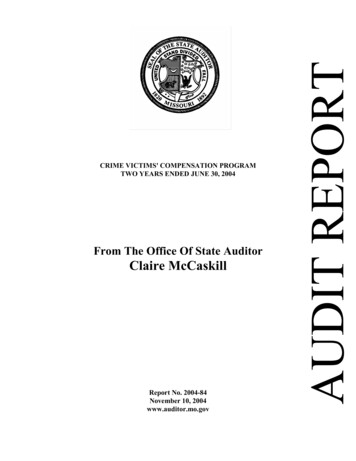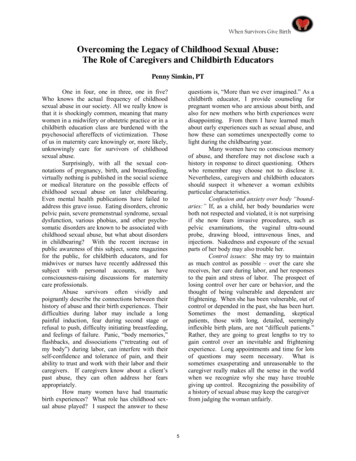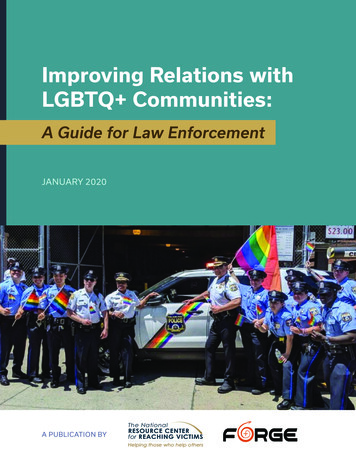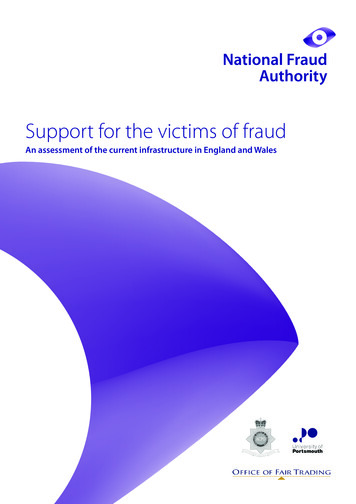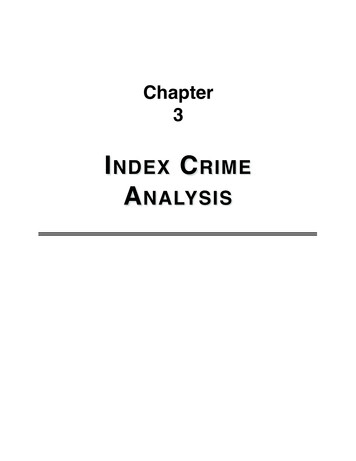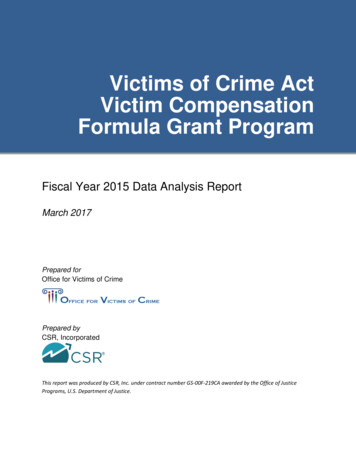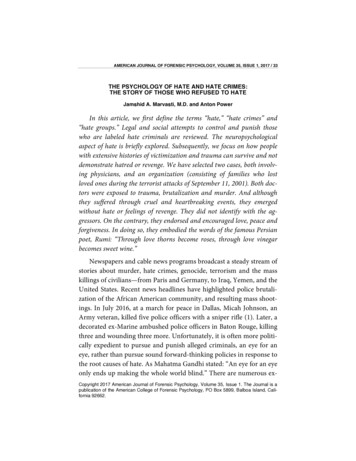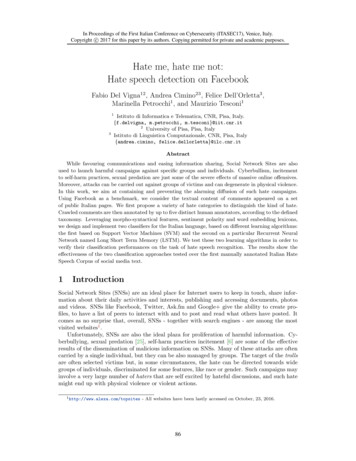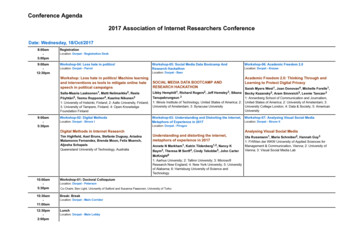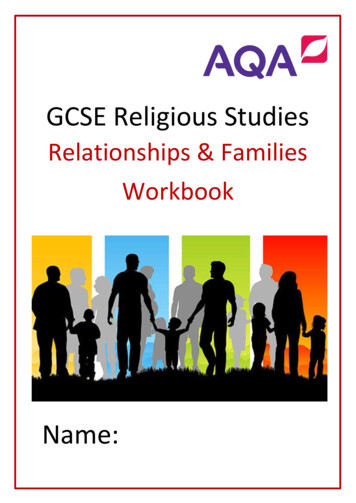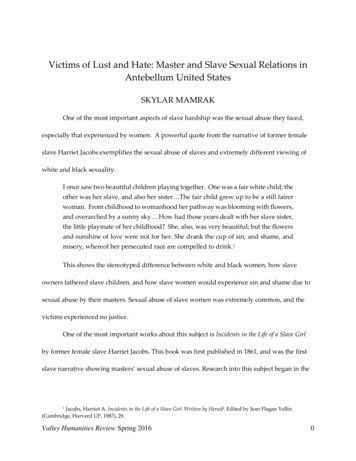
Transcription
Victims of Lust and Hate: Master and Slave Sexual Relations inAntebellum United StatesSKYLAR MAMRAKOne of the most important aspects of slave hardship was the sexual abuse they faced,especially that experienced by women. A powerful quote from the narrative of former femaleslave Harriet Jacobs exemplifies the sexual abuse of slaves and extremely different viewing ofwhite and black sexuality.I once saw two beautiful children playing together. One was a fair white child; theother was her slave, and also her sister The fair child grew up to be a still fairerwoman. From childhood to womanhood her pathway was blooming with flowers,and overarched by a sunny sky How had those years dealt with her slave sister,the little playmate of her childhood? She, also, was very beautiful; but the flowersand sunshine of love were not for her. She drank the cup of sin, and shame, andmisery, whereof her persecuted race are compelled to drink.1This shows the stereotyped difference between white and black women, how slaveowners fathered slave children, and how slave women would experience sin and shame due tosexual abuse by their masters. Sexual abuse of slave women was extremely common, and thevictims experienced no justice.One of the most important works about this subject is Incidents in the Life of a Slave Girlby former female slave Harriet Jacobs. This book was first published in 1861, and was the firstslave narrative showing masters’ sexual abuse of slaves. Research into this subject began in theJacobs, Harriet A. Incidents in the Life of a Slave Girl: Written by Herself. Edited by Jean Flagan Yellin.(Cambridge, Harvard UP, 1987), 29.1Valley Humanities Review Spring 20160
1970s, during the feminist movement, and took off in the 1980s and 1990s, with many works onthis subject coming about. Jacobs’ Incidents was published under the pseudonym of Linda Brent.Scholar Jean Fagan Yellin discovered that Jacobs was the true author in the 1980s; however, shebegan this work during the 1970s.2 Scholar Catherine Clinton has contributed to this subject,with works such as Half-Sisters of History: Southern Women and the American Past (1994) and abook chapter entitled “Souls of Darkness: Dominance and Submission in the Narratives ofFrederick Douglass and Harriet Jacobs” (1997). Also, scholar Adrienne D. Davis wrote about“Slavery and the Roots of Sexual Harassment,” which also looks into the sexual abuse of slaves.Though these works are just the tip of the iceberg, they show that research into masters’ sexualabuse of slaves is fairly recent.3How and why did slave owners make use of sexually abusing their slaves? How andwhy did slaves respond to sexual abuse? Also, how did the white men’s assumption of blackwomen’s submissiveness arise? There are a number of reasons why slave owners sexuallyabused their slaves: economic gains, desire for domination and control, and as a form ofpunishment;4 conversely, slaves also used sex to rebel through resistance, abortion, andinfanticide.5 First, after the Trans-Atlantic slave trade ended in 1808, masters needed to keep2Nakao, Annie. “Her tale was brutal, sexual. No one believed a slave woman could be so literate. But nowHarriet Jacobs has reclaimed her name.” SFGate online newspaper (June 23, 14.php3 Glassco, Jalyn. “Master Slave Sexual Abuse.” College of Wooster (May 8, riography/4 Foster, Thomas A. “The Sexual Abuse of Black Men under American Slavery.” Journal of the History ofSexuality (University of Texas Press, 2011), 445-464.https://muse.jhu.edu/journals/journal of the history of sexuality/summary/v020/20.3.foster.html5 Hine, Darlene C. “Female Slave Resistance: The Economics of Sex.” Western Journal of Black Studies, (WSU,1979). http://eric.ed.gov/?id EJ210341Valley Humanities Review Spring 20161
getting more slaves without buying them, hence getting them to reproduce, either with themasters or through forced relations with other slaves.6 Next, masters desired completedomination over the mind, body, and soul of their slaves. Sexual submission of female slaveswas one-hundred percent expected, but it was not always gained, as will be shown later in thepaper. Sex was another powerful form of ensuring the authority of masters over slaves.7 Lastly,slave owners used sex as a form of punishment.8 Rape and sexual assault are much moredemeaning than other forms of physical punishment such as flogging. This took away theslaves’ privacy, dignity, and every ounce of control that they previously had over their body.Rape would have been a much more effective way to ensure that a slave would comply withwhat the master desired.On the other hand, masters were not the only ones making use of sex in thisrelationship. Slaves also used sex as a weapon, but as a weapon of resistance instead ofoppression. They rebelled by refusing sexual relations with masters and/or other slaves andsometimes aborting children that masters had impregnated them with.9 The sexual relationshipbetween a slave and a master had potential benefit for both parties as weaponry. Yet, whatabout when slaves had supposed consensual relations with their masters? This paper willaddress this issue by asking what can be considered consensual relations, and how to identifywhether slaves and masters could even have consensual sex. The issue of sexual relationsBoundless. Women and Slavery - Boundless Open Textbook. (Boundless U.S. History. July 21, 2015)Brooten, Bernadette J., ed. Beyond Slavery: Overcoming Its Religious and Sexual Legacies. (New York: PalgraveMacmillan, 2010), 295.8 Foster, “The Sexual Abuse of Black Men under American Slavery.”9 Hine, “Female Slave Resistance.”67Valley Humanities Review Spring 20162
between masters and slaves is a crucial component of researching slavery, so that citizens andhistorians alike can have a better understanding of American slavery.Though morally wrong, slavery was a very profitable institution. Since it was soprofitable, slaves were continually being brought to the United States of America from 1619until 1808 when the government banned the Trans-Atlantic slave trade. Slave owners thought ofan effective way to ensure that there were continuously more slaves, without the slave trade.This is why they would force reproduction on their slaves, but how did they do this? Mastershad two different methods for ensuring that their slaves would reproduce. Either mastersthemselves would engage in forced sexual relations with their slaves, or they would force twoslaves to engage in sexual relations for the purpose of reproduction. Forcing slaves to reproducewas also known as “slave breeding.”10 There were also arranged marriages between two slavesthat masters thought would produce physically productive children.11 Former slaves Sam andLouisa Everett said, “if their master thought that a certain man and women might have strong,healthy offspring, he forced them to have sexual relations, even though they were married toother slaves.” This goes to show how slave masters viewed slaves as animals, not even allowingthem freedom in their sexual activities. As said by William Ward, a former slave from Georgia,“Dey uster [used to] take women away fum dere husbands an’ put wid some other man toBoundless Textbook, Women and Slavery.Mann, Susan. “Slavery, Sharecropping, and Sexual Inequality.” Signs: Journal of Women in Culture andSociety (1989), 790. ticle 1000&context soc facpubs1011Valley Humanities Review Spring 20163
breed jes’ like dey would do cattle.”12 Scholar Bernadette Brooten has shone light upon the“sexual economy” of slavery.13 Fertility also made a slave more valuable, and thereforeimpregnating a slave was doubly profitable. There would be one more slave (the baby), and theslave mother would be more profitable to sell.14 Another quote from Harriet Jacobs, a formerslave, is, “women are considered of no value, unless they continuously increase their owner’sstock. They are put on a par with animals.”15However, the slave women who were impregnated most often had inadequatehealthcare. Also, the care of slave children was most often carried out communally. Slavemothers were forced to work and had little time to care for their babies. Also, the fathers wereoften absent. This was because either he was the slave master and wanted nothing to do withthe child, or he was an enslaved male and either did not want to help, could not because he hadto work, or because him and the mother were separated (most likely by one being sold toanother master).16 This displays how concerned slave owners were with economic gain. Theywanted the women to produce healthy babies, but were unwilling to assist in this. Also, whitemen did not have to offer emotional or physical support to slave children that they fathered.17This all continued the sexual abuse of slaves by masters. Though profitability was a mainNational Humanities Center. “On Slaveholders’ Sexual Abuse of Slaves.” News of the National HumanitiesCenter. (North Carolina 1937), 21 Sept, enslavement/text6/masterslavesexualabuse.pdf13 Brooten, Beyond Slavery, 13.14 Hallam, Jennifer. “The Slave Experience: Men, Women, and Gender.” (PBS 2004). Accessed October 12,2015. history.html15 Jacobs, Incidents in the Life of a Slave Girl, 49.16 Mann, “Slavery, Sharecropping, and Sexual Inequality,” 781.17 Brooten, Beyond Slavery, 193.12Valley Humanities Review Spring 20164
motivation for slave owners to engage in sexual relations with their slaves, it was not the onlyone.Slave owners desired complete control and domination over their slaves, and engagingin sexual acts with them was one way to assert their dominance and proclaim to the slave thatthey had control over slaves’ bodies. As described by Harriet Jacobs about her master, “Dr. Flintloved money, but he loved power more.”18 Slaves were seen not as humans, but as property.Since slaves were legally owned by their masters, female sexuality was also seen as the propertyof the masters.19 James Henry Hammond, a plantation owner with more than 300 slaves,oppressed his female slaves by sexually abusing them. He also intervened in the family lives ofhis female slaves, with the aim of showing that could control all aspects of their lives. As onescholar has argued, “sexual exploitation was one of the most intrusive ways masters asserteddominance over their slaves as it further removed a slave’s right to her own body.”20Though beatings also took away the slave’s control of their bodies, sexual dominationcomprises an entirely different realm compared to physical or mental domination. The slaveowners were not just punishing their slaves physically on their external bodies; they werepenetrating the female slave’s bodies, even taking away the security they might have had that atleast their internal bodies were safe from master domination. Men used, or attempted to use,the bodies of female slaves for sex whenever they saw fit. However, this was not always theJacobs, Incidents in the Life of a Slave Girl, 80.Brooten, Beyond Slavery, 295.20 Dirkse, Lindsey. “Slavery & Place: The South Carolina Case.” (University of North Carolina at Chapel Hill2010) Accessed October 12, 2015. y Humanities Review Spring 20165
case, as will be discussed below.21 Female sexual abuse reinforced the display of domination ofmasters over slave men and women. Slave men were unable to protect slave women from beingvictims of sexual abuse, therefore emasculating them and taking away their role as protectors ofwomen.22Male slave owners were not the only ones that took advantage of slaves sexually. Thereis also evidence that elite white women coerced enslaved men into sexual relations. During thistime period, women were still considered to be subservient to men and played a submissiverole in their lives. Since white women were typically dominated by white men, these whitewomen most likely sexually abused male slaves for purposes of domination and control.Abusing male slaves was a way for these women to feel that they had some aspect ofdomination and/ or control in their own lives, and to escape the submissive role they wereforced into by their husbands and society.23 A quote from an unnamed former slave fromGeorgia exemplifies the submission to which black and white women were expected to adhere:“In them times white men wen [went] with colored gals and women bold[ly]. Any time theysaw one and wanted her, she had to go with him, and his wife didn’t say nothin’ bout it.”24 Thisdisplays the expectation by men that they could engage in relations with women besides theirwives, relations which were forced upon the enslaved females, and usually neither the whitewomen nor the black women could stop this from happening or confront the issue. This desireBrooten, Beyond Slavery, 295.Foster, “The Sexual Abuse of Black Men under American Slavery”.23 Allain, Jacqueline. “Sexual Relations Between Elite White Women and Enslaved Men in the AntebellumSouth: A Socio-Historical Analysis.” Student Pulse - Online Academic Student Journal. (2013).24 National Humanities Center.2122Valley Humanities Review Spring 20166
by masters for domination and control over their slaves ties into the next reason why masterssexually abused their slaves.Masters expected to engage in sexual relations with their slaves, and some female slaveswere sold exclusively for the purpose of concubinage.25 But why was this so, and how didwhites’ stereotype of black women’s sexuality come about? Men thought African-Americanfemales should be available for sexual relations with any black or white man. In this time,whites viewed blacks as completely separate beings. They were considered property andtreated like animals. Since whites treated them like animals, this perpetuated the stereotype thatblack sexuality was more animalistic, and therefore many white men saw it as more attractive.The supposed animalistic nature of black women’s sexuality was a stark contrast to theassumed purity and submissiveness of white women.26 As one scholar has argued, “whitesociety believed black women to be innately lustful beings. Because the ideal white woman waspure and, in the nineteenth century, modest to the degree of prudishness, the perception of theAfrican woman as hyper-sexual made her both the object of white man’s abhorrence and hisfantasy.”27 The laws during the nineteenth century also fed the stereotype of black women’ssexuality being promiscuous and lustful there were no laws in place protecting black womenfrom sexual assault. This is because white Americans thought black women were unable to beraped because they were supposedly “impure.” However, they were only impure because ofslavery, so whites used sexual abuse of their slaves to justify the ideas that black women wereBoundless Textbook, Women and Slavery.Brooten, Beyond Slavery, 253.27 Hallam, “The Slave Experience.”2526Valley Humanities Review Spring 20167
impure.28 Impurity in this context means non-virginal, and usually frequently sexually active,either with one or multiple men. One scholar argues, “some whites defended the sexualexploitation of enslaved women as necessary to protect white womanhood from men’s basepassions; slaveholders, they argued, could satisfy their sexual appetites with enslaved women,thereby preserving white women’s purity.” African-American women were also referred to as“whores,” a derogatory term for a sexually promiscuous woman. Also, there was nopunishment for white men for raping their female slaves because slave bodies legally belongedto their owners.29 Most of the time, masters engaged in, or tried to engage in, sexual relationswith young, single female slaves, but occasionally married slaves were raped.30The institution of slavery put enslaved women into one of two categories. Either theywere considered to be a “Mammy” or a “Jezebel.” Mammy was thought of as being asexual,usually worked in the home, and exemplified “ideal slave behavior.” She was seen as a loyalcaregiver and sometimes as a “surrogate mother” who was totally unappealing to white menbecause she was generally depicted as overweight and older, with typical African-Americanfeatures. This pleased the masters’ wives, since they did not have to worry so much about theirhusbands engaging in relations with a slave that was seen as maternal and unattractive. In bluntcontrast to the Mammy figure was Jezebel. Jezebel was an over-sexualized female slave thatsupposedly acted solely based upon her sexual desires. She was seen as a temptress that couldallure “innocent” men (slave owners and/ or overseers) into sexual relations with her. BrootenBrooten, Beyond Slavery, 43.Brooten, Beyond Slavery, 45.30 Hallam, “The Slave Experience.”2829Valley Humanities Review Spring 20168
has argued, “the ideological construct of the lascivious Jezebel legitimized white men’s sexualabuse of black women; for if black women were inherently promiscuous, they could not beviolated.”31 Some of these “jezebels” were female slaves that, as previously mentioned, weresold for the purposes of concubinage. They were referred to as “fancy maids.” This means thatthe female slave would live with the master, and usually engage in sexual relations with him,but has a lesser status than his wife.That white men saw these black women slaves as more attractive did not give them anadvantage in this institution. These concubine slaves had even less of a chance of resisting theirmasters’ advances, since they were sold solely for the purposes of sex and therefore expected tobe available for this whenever the master desired.32 Jacobs said, “if God has bestowed beautyupon her [the female slave], it will prove her greatest curse.”33 Many masters did engage insexual relations with female slaves, generally without caring how their wives’ felt about it.Another example from Jacobs discusses this aspect of the master and slave relationship:The slave girl is reared in an atmosphere of licentiousness and fear When she is14 or 15, her owner, or his sons, or the overseer, or perhaps all of them, begin tobribe her with presents. If these fail to accomplish their purpose, she is whippedor starved into submission to their will.34Many slave women were subjected to sexual abuse by multiple men on just oneplantation, offering them little hope for resistance. Since sexual relations were usually forcedand unpleasant for the slave, slave owners used sexual abuse as a form of punishment.Brooten, Beyond Slavery, 45.Boundless Textbook, Women and Slavery.33 Jacobs, Incidents, 28.34 Ibid., 51.3132Valley Humanities Review Spring 20169
Violence was always a threat to slaves. No matter how hard they worked, there wasalways a chance they would not be doing enough to please their master, and then would bepunished.35 There is a famous court case, State v. Hoover, of sexual violence against a slave,which took place in 1839. John Hoover was a land and slave owner residing in the small town ofStatesville, North Carolina.36 A scholar has argued, “it would appear that Hoover wasdesperately and violently trying to make Mira [his slave] abort her child, perhaps because hehad fathered the baby or resented the man who had, or perhaps because he was driven by deepseated emotions that defied understanding, even for Hoover.” It is likely that Hoover fatheredMira’s child, since it was well-known in his community that he sexually abused his slaves.They [white residents of Statesville] probably believed that fornication by whitemales in southern society was tolerable but not as acceptable with women of adarker skin color Yet those, like Hoover, who practiced promiscuous sexualliaisons coupled with extreme violent behavior with slave women could and didevoke the wrath of the community in which they lived.37Since Mira refused to abort her baby, Hoover felt that she deserved the ultimatepunishment: she was sexually abused and tortured to death. The extreme torturing occurredfrom approximately December 15, 1838 to March 27, 1839 (her death). Hoover was the onlyslave master in the South to be hanged for killing a slave, probably because a new law enactedin 1817, giving slaves more protection, stated that slaves could be punished but not killed.However, people in the community spoke out not about the slave abuse, but about Hoover’sMann, “Slavery, Sharecropping, and Sexual Inequality,” 788.Morton, Patricia, ed. Discovering the Women in Slavery: Emancipating Perspectives on the American Past.(Athens, Georgia: University of Georgia Press, 1996), 50.37 Morton, Discovering, 51.3536Valley Humanities Review Spring 201610
antisocial personality, because of a southern “code of honor” and white male communitymembers were unlikely to get involved in a master/ slave relationship other than their own.Psychologists starting in the 1990s referred to Hoover as having a “sexual perversion,” possiblysadomasochism, that led him to abuse and beat Mira. Sadomasochism is when someonereceives pleasure from inflicting pain on another person. Analysts of Hoover’s life and courtcase display that he most likely abused his wife and children as well.38 This case shows thatsexual abuse was used as a punishment, usually accompanied by physical abuse. There is also aquote from the narrative Twelve Years a Slave by Solomon Northup that shows the physical andsexual punishment faced by slave women:If Patsey [23 year-old slave] uttered a word in opposition to her master’s will, thelash was resorted to at once, to bring her to subjection; if she was not watchfulabout her cabin, or when walking in the yard, a billet of wood, or a broken bottleperhaps, hurled from her mistress’s hand, and would smite her unexpectedly inthe face. The enslaved victim of lust and hate, Patsey had no comfort of her life.39The jealous mistress would physically abuse Patsey, while the master sexually abusedher other times, showing how this abuse was often intertwined.Another case of sexual abuse led to death, but in a completely different way. The case ofslave Celia and master John Newsome took place in Callaway county, Missouri in the 1850s.Newsome purchased Celia when she was 14 years old. Newsome certainly took advantage ofher recent sexual maturity by raping her repeatedly from when she was purchased, causing herto bear two of his children. Though Celia had already considered the idea, George (a slave Celia3839Ibid., 49-56.Northup, Solomon. Twelve Years a Slave. Louisiana State University Press (1968), 143.Valley Humanities Review Spring 201611
was involved with) encouraged Celia to end Newsome’s sexual abuse. “On the night of June 23,1855, Newsome made his last demand. As he approached Celia in her cabin, she hit him with astick, causing him to fall to his death.” Celia had a very public trial, which ended in her beinghanged on December 21, 1855, at the age of nineteen. In the Hoover case, the courts wentagainst the ideology of white social order, while in Celia’s case the white social order wasupheld. Though this case was not necessarily sexual abuse as a form of punishment, Newsomedid not listen to Celia’s pleas to end the sexual abuse, but, most likely to punish her for this, hecame to her cabin every single night.40 However, Celia’s murder of her abusive master brings upthe next point of slave response to sexual abuse.Some female slaves responded to their masters’ sexual abuse in order to rebel againsttheir masters, the abuse, and/or the entire institution of slavery: “as often as black men, blackwomen rebelled against the inhumanities of slave owners.”41 While male slaves resisted bydoing things such as refusing to work or breaking tools, females were able to resist in sexualways. The case of former slave from North Carolina, Harriet Jacobs, is an example of theresistance of sexual abuse that some slaves utilized. When she was still a child, Jacobs waspurchased as a slave by a man, Dr. Flint. Though Flint was married, when Jacobs reached sexualmaturity, he began to pursue her, though she was not the first of his slaves to be sexuallypursued by him. Flint would whisper sexual things to Jacobs, and incessantly tried to coerce herinto submission and concubinage.42 “For years, my master had done his utmost to pollute myMorton, Discovering, 53 (whole paragraph).Hallam, “The Slave Experience.”42 Jacobs, Incidents, 27-36.4041Valley Humanities Review Spring 201612
mind with foul images, and to destroy the pure principles in calculated by my grandmother,and the good mistress of my childhood.”43 Flint even went as far as to build a cabin for Jacobson his property so he could sexually abuse her. However, Jacobs hatched a plot so she couldresist Flint. Though Flint was constantly frustrated with Jacobs for trying to resist him, hewould not sell her to anyone because of his obsession with gaining her submission.Fortunately, though it was a struggle, Jacobs was able to resist Flint throughout her entire life,though he incessantly pursued her throughout the country.44Though this is a prominent example of female slave resistance of sexual abuse, it iscertainly not the only case. As mentioned previously, the slave Celia resisted her masterNewsome’s sexual advances by eventually murdering him.45 Darlene Hine argues the mainmethods of female slave resistance. They include sexual abstinence, abortion, and infanticide.Jacobs is an example of sexual abstinence, but some slaves went further than that. Some femaleslaves were unable to resist the sexual advances of their masters, and were forciblyimpregnated. Though abortions during this time period were extremely dangerous, slavewomen were willing to abort their unwanted fetuses to rebel against their owners, deprivingthe owners of the economic gain the child would have brought, and lessening their masters’feelings of superiority and control. Others participated in infanticide. If unable or afraid to abortthe child, some slave women would carry the child until birth, deliver the child, and then killthe child within a year of birth. Though this seems cruel, one must look at the terrible situationsIbid., 54.Jacobs, Incidents, 27-85.45 Morton, Discovering the Women in Slavery, 53.4344Valley Humanities Review Spring 201613
that female slaves were placed in to see their reasoning for killing their own child. The femaleslave would most likely have psychological damage from being enslaved and being sexuallyabused. Then, after the abuse, the women had to carry the baby they were forcibly impregnatedwith, knowing that their master was pleased and would benefit economically from the motherand child. Even if the mother was willing to raise the baby and care for it, she would most likelyhave no help or support from the father, be subjected to harsher treatment from the master’swife, and be forced to watch the child became a slave. Once all these factors are taken intoaccount, it does not seem unreasonable that a slave mother would want to abort or commitinfanticide on her child.46There was also another way that slaves used sex: “sometimes female slaves acquiescedto advances hoping that such relationships would increase the chances that they or theirchildren would be liberated by the master.” However, this was a rare occurrence. Slaves usuallywere not willing to sacrifice their reproductive abilities and dignity just in the hope of freedom.Also, slave owners that fathered slave’s children rarely treated them well. Most of the time, theywere sold off to other slave owners, because the jealous wives did not want reminders of theirhusbands’ infidelity.47 “He [Flint] never allowed his offspring by slaves to remain long in sightof himself and his wife.”48 This was the attitude that most slave owners who fathered slaveshad. There is yet another master and slave dynamic that must be looked into carefully.Hine, “Female Slave Resistance.”Hallam, “The Slave Experience.”48 Jacobs, Incidents, 55.4647Valley Humanities Review Spring 201614
In some cases, where slave owners did not force themselves on slaves, but they engagedin sexual relations together. This raises the question of “consensual” sexual relations. Consent isdefined as permission for something to happen or agreement to do something. However, fromtoday’s point of view, it is clear that the master and slaves relationship was inherently nonconsensual. African-Americans were forced into slavery, and clearly suffered from their lowerstatus. Since slave owners consented to owning slaves, but slaves did not consent to beingowned, could consensual sexual relations have been possible? Today, most people would sayno, since today consent is defined as yes means yes, and both parties must agree to the entirerelationship. However, this was not the case for the nineteenth century. Wives were supposedto be submissive to their husbands, and not experience any of their own feelings of sexualdesire, yet be available for sex when the husband’s desired. Sex for women was only acceptablewithin marriage, and even then was supposed to be infrequent and not too enjoyable. Men wereallowed to engage in pre-marital sex, and it was more acceptable for them to have strong sexualfeelings.49 Even in slave marriage, the black male slave was considered the head of the family.Furthermore, all women in America at this time were considered property, not just slavewomen.50Perhaps the most famous supposedly consensual case of master and slave sexualrelations is that of former president Thomas Jefferson and his slave Sally Hemings. Muchevidence indicates that Jefferson and Hemings engaged in sexual relations beginning in theRadek, Kimberly M. “Women in Literature: Women in the 19th Century.” Illinois Valley CommunityCollege (21 Ap
One of the most important works about this subject is Incidents in the Life of a Slave Girl by former female slave Harriet Jacobs. This book was first published in 1861, and was the first slave narrative showing masters' sexual abuse of slaves. Research into this subject began in the

